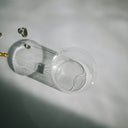Hair loss can be a significant concern for many people, often leading to anxiety and self-consciousness. Understanding the signs of balding is crucial for early intervention and management. This article will guide you through the indicators that may suggest you are starting to lose your hair. By recognizing these signs, you can take proactive steps to address your hair loss effectively.
Table of content
How to tell if you're going bald?
To determine if you are going bald, look for specific signs such as thinning hair, receding hairlines, and bald spots. Additionally, pay attention to the amount of hair you shed daily—losing 50 to 100 strands is normal, but significantly more could indicate a problem. You might also notice changes in your hair’s texture or volume. If you observe any of these signs, it’s advisable to consult a healthcare professional for further evaluation and potential treatment options.
Now that we have addressed the basic indicators, let's delve deeper into understanding each sign of balding in more detail.
As your leading source for hair health information over the past 4 years, we never compromise on accuracy. When it comes to your health, you deserve information you can truly rely on - and earning your trust is our top priority.
Here's how Scandinavian Biolabs ensures every piece of content meets the highest standards of accuracy and integrity:
- Credentialed Experts: Our reviewers are actively practicing doctors and medical researchers
- Stringent Reviews: Content undergoes rigorous editing by subject specialists and review by a practicing doctor.
- Evidence-Based: We rely on well-established research from trusted scientific sources like peer-reviewed journals and health authorities.
- Full Transparency: Our editorial standards, writer credentials, reviewer credentials, correction process, and funding are all publicly documented.
- Independent Voice: While we do promote products, we operate in a vacuum to business operations. Our main goal is just an unwavering commitment to providing medically-sound guidance.
You can count on Scandinavian Biolabs to consistently deliver the trustworthy health information you deserve. Read our Editorial Standards.
Thinning Hair
One of the earliest signs of balding is thinning hair. You may notice that your hair feels less dense or that your scalp is more visible than before. This can happen gradually, making it easy to overlook at first. Pay attention to the overall volume of your hair and how it appears when styled; if it seems less full or flat, it might be a signal of hair loss.
Receding Hairline
A receding hairline is a hallmark of male and female pattern baldness. It usually starts at the temples and gradually moves back. In men, it’s often characterized by an “M” shape, while women may notice more subtle changes. If you find that your hairline is shifting or that your forehead appears larger, this could be a sign that you are going bald.
Bald Spots
Bald spots can appear on various parts of the scalp and are typically more pronounced. They may develop suddenly or over time. If you find patches of hair missing or areas where the hair has significantly thinned, it is a clear indication of hair loss. These spots may occur due to conditions such as alopecia areata, a disorder that causes hair to fall out in round patches.
Increased Hair Shedding
Changes in Hair Texture and Volume
Changes in the texture and volume of your hair can also signal that you are going bald. If your once thick and lustrous hair begins to feel fine, brittle, or lifeless, this could be a sign of hair loss. Additionally, if your hair no longer holds styles the way it used to or seems flat, it might indicate underlying issues causing hair thinning.
Family History of Hair Loss
Your genetics play a significant role in whether you experience hair loss. If you have family members, particularly close relatives, who have experienced baldness, you might be predisposed to it as well. Understanding your family history can help you anticipate potential hair loss and take preventive measures early on.
Consulting a Professional
If you notice any of these signs, it's essential to consult with a healthcare professional or a dermatologist. They can provide you with a proper diagnosis and discuss various options for treatment. Treatments may include topical solutions, medications, laser therapy, or hair restoration procedures, depending on the severity of your condition.
Preventive Measures and Treatments
While some hair loss is inevitable, there are several strategies to help manage and potentially slow down the process. Incorporating a balanced diet rich in vitamins and minerals, reducing stress levels, and avoiding harsh hair treatments can contribute to healthier hair. Additionally, over-the-counter treatments like minoxidil can be effective for some individuals in promoting hair regrowth.
In conclusion, recognizing the signs of balding early on can be beneficial in addressing hair loss effectively. By monitoring your hair health and consulting with professionals, you can take proactive measures to manage your hair loss and maintain your confidence.
Ultimately, remember that experiencing hair loss is a common issue, and many individuals encounter it at various stages of life. Approaching the situation with a positive mindset and seeking help when needed is key to navigating this journey.
```Tired of Thinning Hair? Try a Clinically Tested Serum.
Looking for a natural way to regrow hair and achieve a thicker, fuller head of hair? Ditch the stinging nettle for hair loss – Bio-Pilixin Serum is a drug-free hair activation serum that delivers clinically tested results.
Here's why Bio-Pilixin is superior:
- Clinically Tested Results: 93% of users saw a reduction in hair loss, and 73% experienced increased hair density.
- Safe and Natural: Unlike harsh chemicals, Bio-Pilixin uses plant growth factors derived from stem cell technology to nourish hair follicles and stimulate growth.
- Fast-Acting: See visible results in as little as 45 days (most typically see results within 150 days).
Stop wasting time on unproven remedies. Bio-Pilixin is the safe, natural serum you've been searching for.
Read more:






